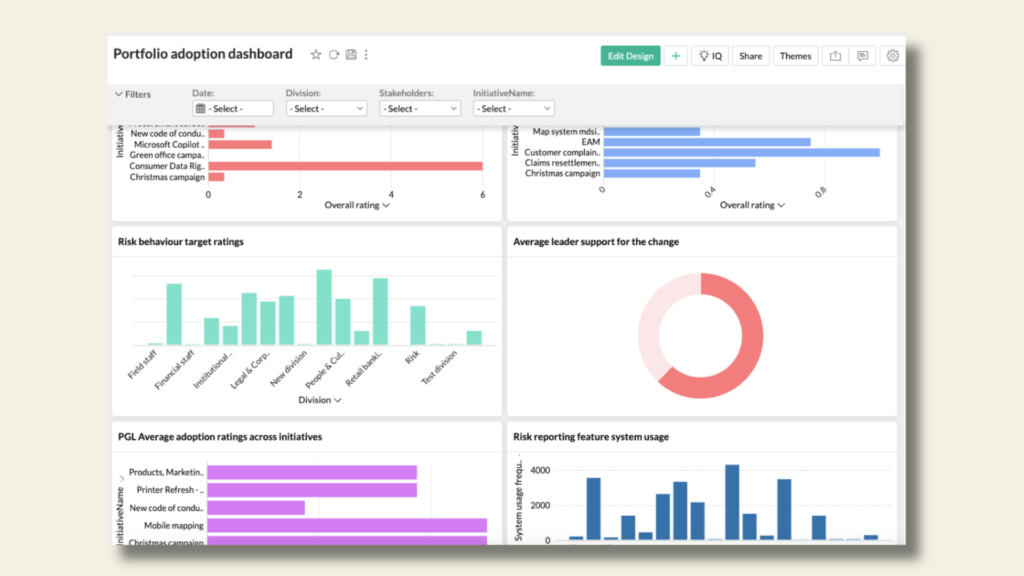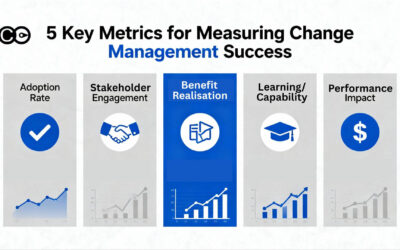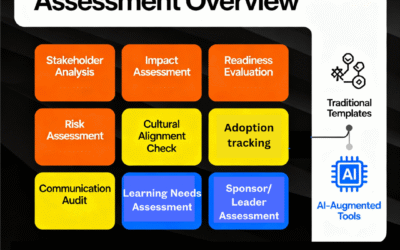Let’s start with an uncomfortable truth: most organisations juggling multiple transformations—digital overhauls, restructures, mergers—end up with stalled initiatives, overwhelmed employees, and leaders questioning ROI. The problem isn’t a lack of effort. It’s a lack of strategic alignment between the existing change management maturity level and the portfolio-level outcomes executives truly care about.
Success lies in breaking the journey into short-term (3–6 months), medium-term (6–18 months), and long-term (18+ months) goals that directly address how change is prioritised, resourced, and measured across initiatives. Without this, even sophisticated maturity models become shelfware.
There are many facets that comprise change maturity. Rather than addressing every element, here we are focused on key aspects such as driving business change leadership, the importance of understanding the impacts of change across initiatives (impact assessment) and measurement.
Short-Term: Align with Portfolio Priorities
Senior leaders managing a portfolio of changes care about three things: resource efficiency, risk reduction, and speed-to-value. Your job? Show how maturity-building activities will fix their pain points—today. I know … you’re probably thinking … well nothing can be done immediately since anything to do with change maturity can take a long time, right? However, there are clear steps you can take to prioritise your efforts.
Step 1: Map Initiatives to Business Outcomes
- Example: A mining company’s portfolio included 12 concurrent projects. By categorising them into strategic priorities (e.g., safety, cost reduction), the change team identified that 70% of delays stemmed from poor cross-initiative dependency mapping.
- Action: Use portfolio impact visualisations to visually show leaders where overlaps, bottlenecks, or resource gaps exist. Think beyond a heatmap. Heatmap is only one artefact (and in fact may not be the best for decision making)
Step 2: Pilot a Cross-Initiative Process
- Tactic: Implement a standardised change impact assessment for all projects in the next quarter. Focus on:
- Employee capacity: “How many initiatives are targeting the same teams? Same roles? Same time period? Same behaviours?”
- Stakeholder conflicts: “Are competing messages being sent? Are similar capabilities being delivered, but not aligned nor clearly positioned?”
- Result: A financial services firm reduced duplicate communications by 40% in 60 days by centralising messaging across 5 projects. This is in fact a very common and immediate benefit of improved change maturity process capability.
💡 Key insight: Short-term wins must address portfolio-level inefficiencies, not just single projects. Leaders will disengage if maturity feels like an “HR exercise.”

Medium-Term: Build Systems for Scale (6–18 Months)
With early trust established, shift to embedding repeatable processes that reduce friction across initiatives.
Step 3: Integrate Change Metrics into Portfolio Reviews
- Example: A healthcare provider added three change metrics to their monthly project reviews:
- % of initiatives with validated impact assessment
- Average employee sentiment score (pre/post-launch)
- Number of cross-initiative resource risks identified and resolved
- Tool: Use a Change Readiness Dashboard
Step 4: Create a “Change Portfolio Office”
- Structure: A cross-functional team that:
- Reviews all initiatives for change impacts before funding is approved.
- Allocates shared resources (e.g., change champions, training budgets).
- Case study: A retail company cut project approval times by 30% by centralising impact assessments, saving $2.1M annually in wasted planning.
| Portfolio Challenge | Medium-Term Goal | Metric |
| Competing priorities | Align initiatives to strategic themes | % of projects mapped to CEO’s top 3 goals |
| Change fatigue | Cap employee exposure to 2–3 initiatives/year | Avg. initiatives per employee |
| Inconsistent practices | Train 100% of project leads in change basics | % certified in ADKAR® |
Long-Term: Institutionalise Change Practices (18+ Months)
At this stage, maturity means change management is no longer a “function”—it’s how the organisation operates.
Step 5: Embed Change into Governance
- Example: A financial services company tied executive KPIs to portfolio-wide adoption rates, ensuring accountability.
- Process: Integrate change criteria into:
- Investment committees: “No impact assessment = no continued funding.”
- Risk registers: Flag initiatives with low readiness scores.
Step 6: Cultivate a Change Culture
There are many potential levers to pull when it comes to cultivating a change culture. Working on too many things may mean you lose focus and end up not getting results from your various efforts. The best lever to pull for immediate results is that of change leadership. Leaders can directly impact how change is delivered and how it is felt from the employee’s perspective. Done right, the right change leadership behaviours can be reinforced and spread across the organisation through role modelling.
- Tactic: Launch a Change Leadership Index measuring:
- How often leaders role-model change behaviours.
- % of managers practicing behaviours without prompting.
What’s Next?
In the following sections, we’ll dive into crafting metrics that executives can’t ignore, including a step-by-step guide to building a business case for maturity—complete with ROI calculators and stakeholder analysis templates.
📌 Your Move: Download our Change Portfolio Review Playbook to identify gaps in your current approach.

The Power of Metrics: How to Measure What Matters
Building change management maturity across a portfolio of initiatives requires more than just good intentions—it demands measurable outcomes. Metrics are the bridge between your maturity-building efforts and the tangible results senior leaders expect. But not all metrics are created equal. To keep leaders engaged, your metrics need to be actionable, aligned with business goals, and easy to track.
Step 7: Design Metrics That Speak to Leaders
When managing a portfolio of changes, metrics need to reflect the big picture. Here’s how to create metrics that resonate:
- Start with Business Priorities
- Ask yourself: What are the organisation’s top three strategic goals this year?
- Example: If a company’s priority is improving customer experience, track how well change initiatives reduce customer complaints or improve Net Promoter Scores (NPS).
- Focus on Outcomes, Not Activities
- Avoid tracking inputs like “number of training sessions delivered.” Instead, measure outcomes such as “percentage of employees demonstrating new behaviours post-training.” (e.g. based on leader ratings)
- Use Leading and Lagging Indicators
- Leading indicators help you predict success (e.g., % of employees engaged in readiness activities).
- Lagging indicators measure results (e.g., project adoption rates or ROI).
| Metric Type | Example | Why It Matters |
| Leading Indicator | % of initiatives with completed impact assessment | Predicts smoother implementation |
| Lagging Indicator | % increase in initiative adoption rates | Measures actual impact |
| Portfolio-Level Metric | % of projects that directly contribute to strategic goals | Ensures focus on what matters most |
Step 8: Build a Change Dashboard for Portfolio Visibility
Leaders managing multiple initiatives need a clear view of progress across the portfolio. A well-designed dashboard can make this possible.
Here’s what to include in your Change Portfolio Dashboard:
- Portfolio Aggregate Impacts: Visualise which teams or departments are most impacted by change. Move beyond generic traffic light indicators (green = low impact, red = high impact) to flag areas at risk of fatigue. Easy is not always effective in terms of supporting business decision making outcomes.
- Adoption Metrics: Track adoption rates for each initiative and highlight where additional support is needed.
- Resource Utilisation: Show how shared resources (e.g., trainers, change champions) are being allocated across projects.
🛠️ Tool Tip: Platforms like Change Compass can automate data collection and visualisation for your dashboard, saving time and ensuring accuracy.
Practical Example: Using Metrics to Drive Decisions
Let’s look at how an organisation applied these principles in real life:
Case Study: A Retail Chain’s Change Portfolio Overhaul
Scenario: A retail chain was managing 8 concurrent initiatives, including a new CRM system, process redesigns, and supply chain improvements. Employees were overwhelmed, and leaders lacked visibility into which projects were delivering value.
What They Did:
- Short-Term Goal: Within 90 days, they implemented a portfolio change impact visualisation to identify overlaps in impacted teams. This revealed that store managers were involved in 7 out of 8 initiatives simultaneously—leading to burnout and delays.
- Medium-Term Goal: Over the next year, they introduced standardised change impact assessments for all new projects and tied project approval to readiness scores. This increased readiness outcomes.
- Long-Term Goal: After 18 months, they embedded change metrics into their governance process, requiring quarterly updates on adoption rates for all major initiatives.
Results: The company saw improvement in project delivery timelines and a significant boost in employee readiness/adoption scores.

Medium- and Long-Term Goals: Building for Sustainability
Once you’ve delivered short-term wins and established credibility with senior leaders, it’s time to focus on building sustainable systems that scale across the organisation.
Step 9: Institutionalise Change Impact Assessments
A common pitfall in organisations is treating change management as an afterthought—something tacked on once projects are already underway. To build maturity, change impact assessments need to become a non-negotiable part of your project lifecycle.
- Action Plan:
- Partner with your PMO (Project Management Office) or equivalent team to integrate change assessments into project initiation documents.
- Develop a simple checklist for project leads to evaluate readiness factors like stakeholder alignment, resource availability, and potential resistance points.
- Example Checklist Item: “Have all impacted teams been consulted about potential workload increases?”
- Real-Life Application: A financial services firm made stakeholder analysis and impact assessment mandatory before any project funding was approved. This reduced cross-departmental conflicts over resources and priorities.
Step 10: Scale Change Leadership Across the Organisation
One of the biggest barriers to maturity is over-reliance on a small group of change managers or consultants. To achieve long-term success, you need to democratise change leadership.
- Create a Change Champions Network: Identify employees across departments who can act as local change agents. Train them on basic tools like stakeholder mapping and resistance management.
- Incentivise Role Modelling: Offer recognition programs or tie role modelling in the network to career development opportunities.
- Measure Success: Track how often champions are consulted during initiatives and whether their involvement correlates with higher adoption rates.
💡 Pro Tip: Use storytelling to highlight the impact of your champions’ work—e.g., “How Finance’s Change Champion helped reduce resistance during our ERP rollout.”
The Role of Data in Driving Maturity
Data is your best friend when it comes to building credibility and making informed decisions about where to focus your efforts.
Step 11: Use Data Insights to Prioritise Efforts
Not all initiatives—or teams—are created equal when it comes to their ability to handle change. By leveraging data from readiness assessments, pulse surveys, or even historical project performance, you can prioritise where to focus your efforts.
- Example Insight: If pulse surveys show that frontline employees have low trust in leadership communication, prioritise initiatives that include robust communication plans.
- Actionable Tip: Use historical data from past projects (e.g., adoption rates or employee sentiment scores) to predict which upcoming initiatives may face similar challenges.
The Final Stretch: Embedding Change into Your Organisation’s DNA
You’ve laid the groundwork with short-term wins, built scalable systems, and aligned metrics to leadership priorities. Now, it’s time to ensure change management maturity becomes self-sustaining—woven into your organisation’s culture, governance, and daily operations.
Step 12: Integrate Change into Talent Development
Maturity isn’t just about processes; it’s about people. To ensure long-term success, change competencies must be embedded into roles at every level.
Action Plan:
- Leadership Development:
- Include change leadership in executive training programs. For example, a mining company added a module on “Leading Through Complex Change” to its leadership curriculum.
- Measure success through 360-degree feedback on leaders’ ability to role-model adaptability.
- Employee Upskilling:
- Offer microlearning courses on change basics (e.g., “Managing Your Energy During Change”).
- Example: A retail chain used a mobile app to deliver 5-minute daily tips during a major transformation, boosting engagement by 35%.
- Performance Reviews:
- Tie 10–15% of managers’ KPIs to change-related behaviours (e.g., “Proactively addresses team concerns during transitions”).
📌 Tool Kit: Use platforms like LinkedIn Learning or Degreed to curate change management content tailored to different roles.
Step 13: Automate and Optimise
As your portfolio grows, manual processes will become unsustainable. Automation ensures scalability while freeing your team to focus on high-value work.
What to Automate:
- Change Impact Assessments:
- Use AI tools to analyse project documents and flag potential risks (e.g., overlapping initiatives impacting the same teams).
- Example: Using ChatGPT (corporate version, to ensure you are not sharing sensitive data to the internet) to draft initial stakeholder analyses and high level impact assessment, reducing prep time significantly
- Sentiment Tracking:
- Deploy NLP (Natural Language Processing) tools to analyse employee feedback from surveys, emails, or collaboration platforms like Slack.
- Resource Allocation:
- Implement a digital tool (e.g., Smartsheet) to track shared resources (e.g., change champions) across projects and avoid burnout.
| Process | Automation Tool | Outcome |
| Impact assessment | ChatGPT, Change Automator | Faster, data-driven insights |
| Sentiment Tracking | Qualtrics + NLP | Real-time emotion mapping |
| Portfolio Prioritisation | Jira Align + Power BI | Dynamic resource reallocation |
Step 14: Foster a Feedback-Driven Culture
Mature organisations treat feedback as a strategic asset, not an afterthought. Build mechanisms to capture insights from employees, leaders, and customers—and act on them.
Tactics:
- Pulse Surveys:
- Send short, frequent surveys (5-8 questions) during critical phases of initiatives.
- Example: “On a scale of 1–10, how prepared do you feel for the new process rollout?”
- Post-Initiative Retrospectives:
- Host cross-functional sessions to identify what worked and what didn’t. Use frameworks like Start, Stop, Continue to structure discussions.
- Feedback Loops with Leaders:
- Present anonymised employee feedback in leadership forums to drive accountability.
- Example: A healthcare provider shared quotes like “We need clearer deadlines” in executive briefings, prompting better communication.
💡 Pro Tip: Use a “Feedback Action Tracker” to document how input has influenced decisions—and share updates with employees to build trust.
Step 15: Prepare for the Next Horizon
Change management maturity isn’t a destination—it’s a journey. To stay ahead, proactively scan the environment for emerging trends and adapt your approach.
Future-Building Strategies:
- Scenario Planning:
- Conduct workshops to simulate how your organisation would handle disruptions (e.g., AI-driven automation, regulatory shifts).
- Example: A financial services firm used scenario planning to prepare for hybrid work trends, avoiding productivity dips.
- Benchmarking:
- Compare your maturity metrics against industry peers using frameworks like The Change Compass’s Maturity Index.
- Innovation Labs:
- Create cross-functional teams to pilot new tools (e.g., VR for change simulations) or methodologies (e.g., agile change management).
The ROI of Maturity: What’s in It for You?
Investing in change management maturity isn’t just about avoiding failure—it’s about unlocking tangible value. Consider these returns:
| Area | ROI Example |
| Cost Savings | 20–30% reduction in project rework |
| Speed | 25% faster time-to-value for initiatives |
| Employee Experience | 15% boost in engagement scores |
| Customer Impact | 10% improvement in NPS post-change |
Your Call to Action: Start Today
Building change management maturity across a portfolio isn’t easy—but the payoff is immense. Here’s how to begin:
- Assess Your Current State:
- Use The Change Management Institute model of Change Maturity to identify gaps.
- Pick One Short-Term Win:
- Example: Implement a portfolio impact visual in the next 30 days to visualise potential impact overlaps and risks.
- Engage a Senior Sponsor:
- Secure leadership buy-in by linking your plan to their top priority (e.g., “This will reduce project delays by X%”).
Final Thought: Maturity isn’t about perfection. It’s about progress. Start small, demonstrate value, and scale relentlessly.
📩 Want More?
Check out our Change Porfolio section for articles, case studies, tips and examples.






